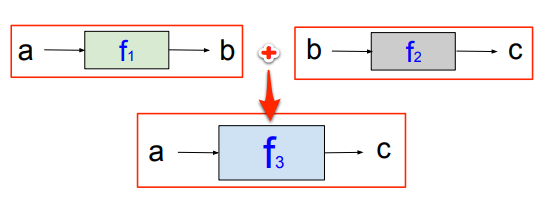The big reveal
A monad chains continuations.
Recall the monad from the hierarchy diagram of Fantasy Land algebras earlier in this chapter?
We'll talk a lot more about Monads in the last unit of our book, but for now let's take a sneak peak at the big picture.
Earlier we saw composition of functions:

That's actually a problem because that's not a Monoid. A Monoid looks like this:

And that's the big reveal. Monads are purple!
Ha. Gotcha!
Besides the color, what can you see that's different between the monadic function and the ones above it?
What about the a going in and the a coming out? That means that if a Monoid accepts a parameter of type A (by convention, a lower case a variable is a value of type A), then it will spit out another a value.
Guess what that's called? When our function returns the same type that it's fed? We call that an endomorphism where en means same and morphism means function; So, it changes from an a to an a. Simple.
What about the chain word used in the a monad chains continuations...



























































